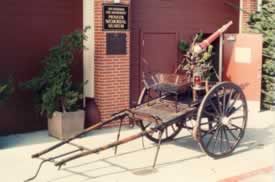
- Guardians Home
- SFFD Home
- Site Map
- Historical Review
- Apparatus
- Chiefs of Department
- Chronology
- Charles H. Ackerson
- Charles J. Brennan
- Keith P. Calden
- Andrew C. Casper
- Emmet C. Condon
- Robert L. Demmons
- John H. Dougherty
- Charles P. Duane
- Joanne M. Hayes-White
- George H. Hossefross
- Francis P. Kelly
- Frederick D. Kohler
- Joseph A. Medina
- Thomas R. Murphy
- William F. Murray
- Jeanine Nicholson
- Edward J. Phipps
- David Scannell
- Patrick H. Shaughnessy
- Albert J. Sullivan
- Dennis T. Sullivan
- Paul J. Tabacco
- Mario H. Trevino
- Edward P. Walsh
- Franklin E. R. Whitney
- Companies
- Events
- Past Events
- SFFD 150th Anniversary
- PPIE 100th Anniversary
- 1906 Expo
- 1989 Quake Party - 2009
- 65' Ladder Presentations
- Broderick & Terry Duel
- Coit Tower 75th Anniversary
- Cole Valley Fair
- Gold Hydrant - April 18th
- Jimmy's Car Show
- Lower Haight Street Fair
- Lotta's Fountain - April 18th
- Musters
- Presidio Car Show
- Station 28 75th Anniversary
- Fireboats
- Firehorses
- Firehouses
- Fires
- In The Line Of Duty
- Museum Collections
- Musters
- Notable People
- Organizations
- Gift Shop
- Volunteers
- Related Links
- Contact Us
- Research Requests
- Photo Gallery
- Videos
- Donations
Museum Collections: Apparatus - Battery Co. No. 3: |
|
1909 Gorter, a single horse drawn monitor unit |
|
 |
|
 |
 |
Builder: Henry Gorter, Fire Department Corporation Yard Manufacturer's Number: Location: Museum Condition: Good, restored Crew: Driver Service History: 1909 organized and assigned to the quarters of Engine Co. No.1, 451 Pacific Avenue In 1895 Henry H. Gorter invented the fire appliance monitor on this apparatus that still bears his name. The Gorter monitor is also referred to as the Gorter high pressure monitor. The vertical movement of the monitor nozzle is on a ball and socket joint which allows a free flow of water at any angle. A roller bearing permits the nozzle to move in a horizontal arc. At full operation with a 2 ½ inch nozzle tip, the monitor can produce a water flow of 1,750 gallons per minute. It is easily handled and controlled by one firefighter. The Gorter monitor is able to throw a stream of water over 250 feet, depending on the nozzle tip size and water pressure. The battery carries a set of four nozzle tips of 1 ½, 1 ¾, 2, and 2 ½ inches. The Gorter monitor on this single horse drawn battery is suspended over the single axle of the unit. This distributes the weight equally in order to relieve the strain on the horse. To place the battery into operation at the fire scene the horse is removed from the apparatus and the draft shafts lowered to the ground. On the bottom front of the draft shafts are toe spikes. These spikes dig into the ground and stop the unit from moving backward during the flow of water. Next, the driver's seat is released forward to make space for the necessary leveling of the monitor table. The table is made level by releasing a spring assisted lock assembly, with the aid of an extension bar, located at the rear of the unit. To assist with additional stabilization, the unit carries two seven foot long outrigger steel bars. The bars are placed through the spokes of each wheel into hand clamps on the table platform. The toe spikes at the bottom of these bars are off-set at a 45 degree angle so when placed into the ground their position is at the perpendicular. The outriggers balance side to side pressure and some forward and back pressure when the battery is in operation. Mr. Gorter thought of everything when building this apparatus. To protect and cool the fireman working at a large fire there is a built-in water curtain located behind the seat on the main stem of the monitor. This fan water curtain is controlled by a small shut off value within easy reach of the firefighter. At the time of the 1906 Fire there were two battery companies in service. Battery Co. No. 2 was destroyed, and then replaced at a cost of $1,750. This unit was built through funds provided by the 1909 Auxiliary Water Supply System bond issue. Between 1922 and 1980 the battery had a tow hitch on the draft shafts which allowed it to be transported behind a motorized apparatus. In the 1950's, the battery was towed to a greater alarm warehouse fire where it poured water onto the smoldering fire continuously for over 24 hours. In 1980 the Battery was restored by the California Correctional Institute at Tehachapi under the direction of Mr. Cal Clason, who was the supervisor of the wood shop. Since its restoration, Battery Co. No. 3 unit has been exhibited at firemen's musters in California, Oregon, Nevada and Arizona. When it is placed into operation at these events, the water supply is usually provided by other visiting department's steam engines. Fire departments that have pumped into the battery include: the Los Angeles County Fire Department, the Los Angeles Fire Department, the Phoenix (Arizona) Fire Department, the Albany Oregon Fire Department and the Woodland Fire Department. Battery No. 3 was last displayed, paraded and demonstrated at the 1906 Expo presented by SFFD Historical Society in 2006. During the living history firefighter's muster demonstration, the water to the battery was supplied by steam engines from the Virginia City (Nevada) Fire Department, the Eureka Fire Department and the California State Firemen's Association Steam Team. The 1906 Expo, the 100th Anniversary celebration of the 1906 Earthquake and Fire, was the largest gathering of steam engines and other horse drawn fire apparatus on the West Coast in modern times. |
|

